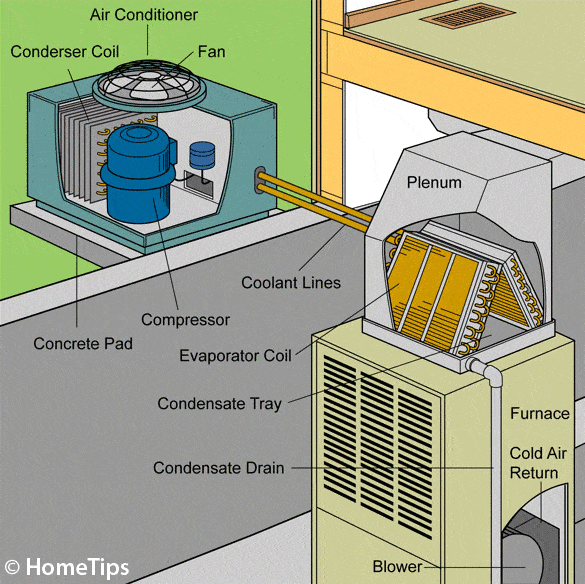| |||
How a Central Air Conditioner Works |
How a Central Air Conditioner Works | |
A clear explanation, with diagrams, of how a central air conditioner cools a house by cycling refrigerant through its system. A central air conditioner has a primary appliance such as an air handler or furnace located in an out-of-the-way place such as a basement or attic. This appliance pumps chilled air throughout the house through a system of air ducts—often the same system utilized by a forced-air furnace during the heating season. One or more thermostats in the house turn the cooling system off and on as room temperatures rise and fall. A central AC runs on electricity and removes heat from air with basic refrigeration principles. When the thermostat signals the air-conditioning system to lower air temperature, a whole sequence of events begins. The air-handling unit kicks on, drawing room air in from various parts of the house through return-air ducts. This air is then pulled through a filter, where airborne particles such as dust and lint are removed—in fact, sophisticated filters may remove microscopic pollutants as well. Then the air is routed to air-supply ductwork that carries it back to the rooms.  A central air conditioner cools with an outdoor compressor and condenser coil connected to an indoor furnace fitted with an evaporator coil. But how does the evaporator coil get cold in the first place? That is where refrigeration principles come into play. Every air conditioner has three main parts: a condenser, an evaporator, and a compressor. With a typical “split system,” the condenser and the compressor are located in an outdoor unit; the evaporator is mounted in the air-handling unit, which is often a forced-air furnace. With a “package system,” all of the components are combined in a single outdoor unit that may be located on the ground or on the roof.) A refrigerant such as freon circulates through copper tubing that runs between these components. This refrigerant receives and releases heat as it raises and lowers in temperature, changing from liquid to gas back to liquid. The refrigerant is especially cold when it begins to circulate through the indoor coil. As the air handler pushes warm air across the coil, the refrigerant absorbs so much heat from the air that it turns into vapor. As a vapor, it travels to a compressor that pressurizes it and moves it through the outdoor coil, which jettisons the heat. A fan also helps to dissipate the heat. The refrigerant then passes through an expansion device that converts it to a low-pressure, low-temperature liquid, which returns to the indoor coil. And so the cycle goes. Get a Pre-Screened Local Air Conditioning Contractor | |

 选择“Disable on www.wenxuecity.com”
选择“Disable on www.wenxuecity.com”
 选择“don't run on pages on this domain”
选择“don't run on pages on this domain”

